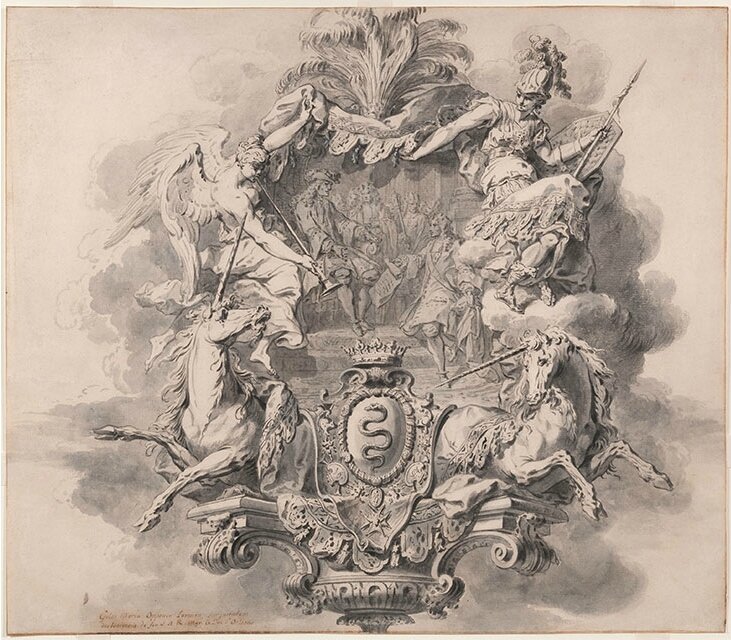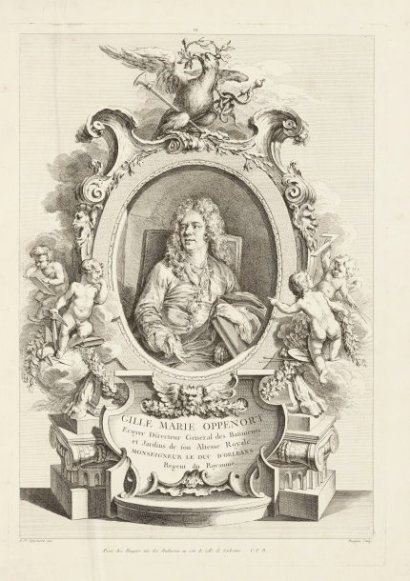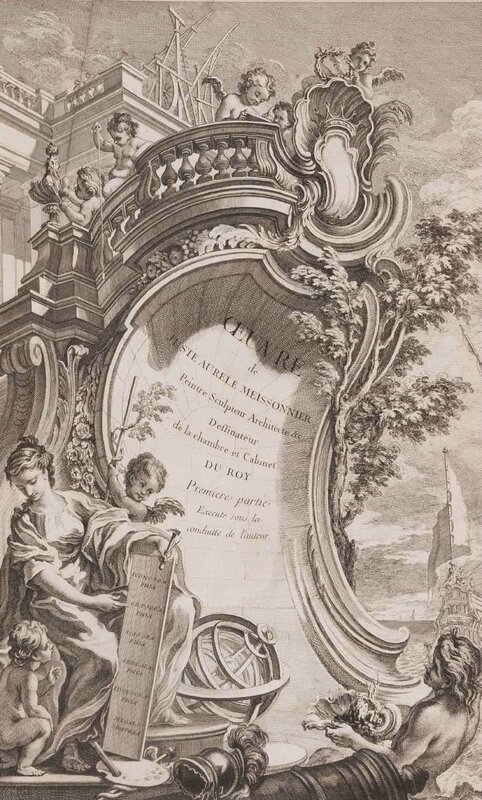Drawings by Gilles-Marie Oppenord and Juste-Aurèle Meissonnier on view at Waddesdon Manor
Gilles-Marie Oppenord, Design for a headpiece or title-page, with the arms of the marquis de Torcy, c 1725. The Rothschild Collection (The National Trust). Photo Mike Fear © The National Trust, Waddesdon Manor.
BUCKINGHAMSHIRE.- An exhibition exploring the work of two of the most innovative draughtsmen and designers of the 18th century, including: Spectacular presentation sheets, as well as drawings for workshop use; designs for interiors, fountains and grottoes, both real and fantastical, and an important group of designs for churches and ritual objects.
Born during the reign of Louis XIV, at a time of unprecedented interest in drawing and extraordinary artistic innovation, Oppenord and Meissonnier are two of the greatest names associated the development of the distinctively French style that reached its peak in the reign of Louis XV, now known as Rococo.
Gilles-Marie Oppenord, Design for a garden fountain (detail); c 1720-c 1730; black ink on paper; 439 x 291mm; Waddesdon, The Rothschild Collection (The National Trust); acc. no. 1857. Photo: Mike Fear © The National Trust, Waddesdon Manor.
This exhibition of 45 drawings, mostly from Waddesdon’s own collections acquired in Paris in the 19th century by Baron Edmond de Rothschild (1845-34), is complemented by two loans, a spectacular Meissonnier design for a projected church for the Order of the Holy Ghost from the V & A and a red chalk Oppenord from the Courtauld Gallery. The majority of these drawings have never previously been shown.
Gabriel Huquier, Portrait of Gilles-Marie Oppenord, from OEuvres de Gille Marie Oppenort, 2ème Receuil, 1900 (later reprinting) . Photo © Kline Books.
The drawings on display include experimental studies and highly finished presentation sheets, drawings for workshop use, others for student instruction, and copies made as part of the process of translating a design into print. There are designs for personal accessories such as gold boxes, furniture and interiors, for real and fantastical palaces, fountains and grottoes as well as an important group of ecclesiastical works. Many would go on to be realised in a variety of materials by builders, masons, carpenters, plasterers, goldsmiths, instrument makers and other craftsmen; others exist only on paper.
Gabriel Huquier, Portrait of Juste-Aurèle Meissonnier, from OEuvre de Juste Aurelle Meissonnier, 1723-1735; Waddesdon, The Rothschild Collection (The National Trust), Bequest of James de Rothschild, 1957; acc. no. 3227. Photo: Mike Fear © The National Trust, Waddesdon Manor.
This exhibition demonstrates the breadth and variety of Oppenord’s and Meissonnier’s creativity, and skill, both valued by collectors and connoisseurs even during the artists’ lifetimes. Prints of their drawings spread their ideas throughout Europe, and further afield, and were copied by other artists and designers long after their designs went out of fashion in France;
Juste-Aurèle Meissonnier, Titlepage, OEuvre de Juste-Aurele Meissonnier, 1723-1735; Waddesdon, The Rothschild Collection (The National Trust), Bequest of James de Rothschild, 1957; acc. no. 3227. Photo: Mike Fear © The National Trust, Waddesdon Manor.
Gabriel Huquier after Juste-Aurèle Meissonnier, Design for a centrepiece for the Duke of Kingston from Œuvre de Juste-Aurèle Meissonnier, 1723-1735; Waddesdon, The Rothschild Collection (The National Trust), Bequest of James de Rothschild, 1957; acc. no. 3227. Photo: Mike Fear © The National Trust, Waddesdon Manor;
Gabriel Huquier, Design for a trade card, 1749, pen, ink and wash, watercolour and black chalk, black chalk, 235 x 148mm; Paris, National School of Fine Arts (ENSBA); inv no. O1750-01. Photo © RMN

/https%3A%2F%2Fprofilepics.canalblog.com%2Fprofilepics%2F1%2F0%2F100183.jpg)
/https%3A%2F%2Fstorage.canalblog.com%2F03%2F02%2F119589%2F96711876_o.jpg)
/https%3A%2F%2Fstorage.canalblog.com%2F11%2F31%2F119589%2F94773502_o.jpg)
/https%3A%2F%2Fstorage.canalblog.com%2F20%2F83%2F119589%2F94772815_o.jpg)
/https%3A%2F%2Fstorage.canalblog.com%2F26%2F72%2F119589%2F75604929_o.jpg)
/https%3A%2F%2Fstorage.canalblog.com%2F59%2F60%2F119589%2F26458628_o.jpg)









/http%3A%2F%2Fstorage.canalblog.com%2F10%2F27%2F119589%2F32662194_o.jpg)
/image%2F1371349%2F20240508%2Fob_d997ec_d21e3e110569bdfa219529297300e28a-1402x.png)
/image%2F1371349%2F20240508%2Fob_4c468b_telechargement-4.jpg)
/image%2F1371349%2F20240508%2Fob_7c1cc0_telechargement.jpg)